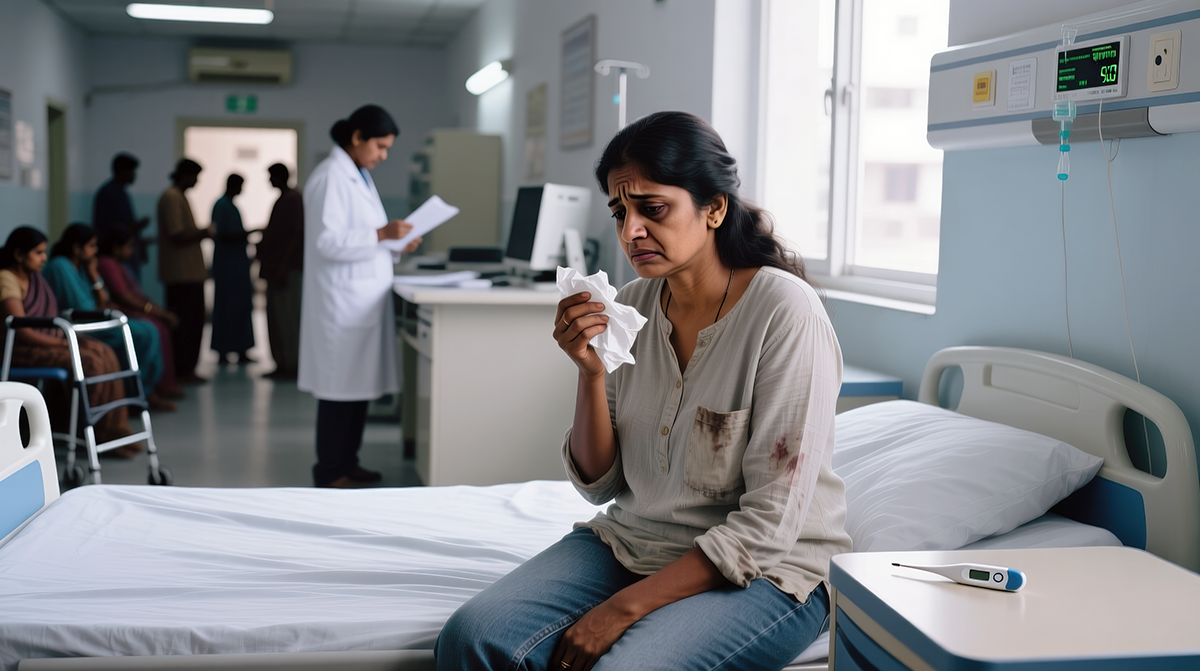Dr. Philp McMillan, John McMillan
Mass vaccination campaigns against COVID created something unprecedented: uniform immune pressure across billions of people simultaneously. This sustained pressure may have exhausted the very T-cell defenses our bodies rely upon to fight all pathogens, not just COVID. Delhi’s September 2025 surge, where sixty-nine percent of households reported illness, may represent the first large-scale warning of what happens when compromised immune systems encounter ordinary viruses.
The Signal From Delhi
In September 2025, researchers from the Indian Council of Medical Research surveyed eleven thousand households across New Delhi as part of their ongoing respiratory disease surveillance. What they found was striking: sixty-nine percent of families had at least one member sick with H3N2 influenza. These weren’t passing colds. People reported prolonged fever, hospitalizations, respiratory distress that wouldn’t resolve.
The World Health Organization’s global influenza surveillance network painted a different picture. Their FluNet database showed influenza activity remaining low worldwide, with most regions displaying typical inter-seasonal patterns. Yet India was experiencing something else entirely. Hospitals filled with severe flu cases that refused to follow the expected course.
This pattern carries an unsettling echo. In early 2021, when COVID surged through India, the world initially dismissed it as a regional problem. That problem had a name: Delta. Within months, Delta swept every continent. When sixty-nine percent of households report illness, up from fifty-four percent in ICMR’s March 2025 surveillance round, you’re witnessing something shift at the population level.
The question worth asking isn’t whether H3N2 suddenly mutated into a superbug. The question is why a normal seasonal flu virus would behave abnormally. The answer may lie not in the virus itself, but in the immune systems attempting to fight it.
Vanden Bossche’s Warning: The Immune Pressure Trap
Geert Vanden Bossche brings an unusual pedigree to his warnings. His career spans GSK Biologicals, Novartis Vaccines, the Bill & Melinda Gates Foundation’s Global Health Discovery team, and Gavi’s Ebola vaccine deployment. His recent work describes the pandemic’s trajectory toward a variant that bypasses the adaptive immune system entirely. He calls it HiViCRON.
The logic proceeds in stages. Mass vaccination created uniform Covid viral immune pressure. Billions developed antibodies targeting the original Wuhan spike protein, driving the virus toward Omicron variants. When breakthrough infections followed, the body’s defense shifted from antibodies to T-cells, those coordinators that activate immune responses to recognize infected cells.
Those T-cells now face evolutionary pressure. In highly vaccinated populations, T-cell immunity creates chronic, low-grade infections strong enough to pressure the virus but not eliminate it. This evolutionary crucible selects for variants with mutations in T-cell recognition sites, allowing new subvariants to achieve dominance faster.
Vanden Bossche’s endgame scenario envisions mounting pressure eventually exhausting the mutation pathway. At that point, the virus would take a quantum leap: not further tweaking of targets, but fundamental change in how it presents itself to the immune system. The entire adaptive immune system would become irrelevant.
In his September 2024 podcast episode “The Endgame,” he stated: “I’m talking about a hyperacute phase of the pandemic, a hyperacute course of individual disease. The number of casualties will be incredibly higher than we would have seen if we would not have had the mass vaccination.”
The most unsettling aspect isn’t the prediction itself. It’s that surveillance systems track spike mutations obsessively while potentially missing the real story in T-cell function. We may be watching the wrong battlefield.
But T-cell suppression doesn’t discriminate by pathogen. Whatever weakens your defense against COVID could also weaken your defense against everything else.
The Coin Flip: When HiViCRON Hivicron Opens the Door to Hiviflu
Dr. Philip McMillan, a UK-based physician documenting post-vaccination patterns through his Vejon Health platform, asked a different question. If Vanden Bossche was right about HiViCRON Hivicron, what happens to all the other viruses those same T-cells normally control? He coined the term Hiviflu as the flip side of the same coin.
COVID depletes immune function, particularly T-cells and interferon pathways. McMillan’s analysis of mRNA vaccine mechanisms identified how modified RNA technology must suppress interferon responses to allow spike protein production. But that suppression weakens both antiviral and anti-cancer defenses. When a population develops degraded interferon responses and exhausted T-cell function, influenza encounters an environment where it can exploit the gap.
The transmission pattern changes revealingly. With normal influenza, symptoms appear quickly and people stay home sick. But when immune responses are suppressed, minimal symptoms mean people circulate freely, carrying and spreading the virus asymptomatically. By the time vulnerable populations become exposed, they can’t mount effective defense.
Delhi hospitals report patients with “prolonged fever” and difficulty recovering from viral infections, according to All India Institute of Medical Sciences emergency physicians documented in The Hindu’s September 2025 coverage. The clinical picture doesn’t match typical seasonal flu. It matches flu encountering compromised immune function.
What We’re Not Tracking
Vanden Bossche’s central warning focuses on a data gap. Surveillance systems track spike protein mutations, hospitalization rates, and variant proportions. What’s missing: nucleocapsid mutations where T-cell evasion evolves, T-cell function in breakthrough infection populations, co-infection rates, and interferon pathway status.
The autopsy gap compounds the problem. No systematic post-mortem analysis examines immune system status in COVID deaths or sudden unexplained deaths following vaccination. As Dr. McMillan emphasized: “There can be no evidence if the research is not being done. Without autopsies, we are flying blind.”
Researchers looking at variant graphs see normal evolutionary drift. Vanden Bossche sees a countdown clock measuring T-cell epitope exhaustion. Without the right data, we can’t determine who’s correct. By the time mortality statistics provide the answer, prevention becomes impossible.
Seasonal flu typically peaks between November and February in the Northern Hemisphere. If Vanden Bossche’s predictions hold, populations would face convergence: a COVID variant bypassing adaptive immunity and influenza exploiting the same immune deficit simultaneously. Watch for rising flu hospitalizations in highly vaccinated countries, prolonged illness, extended recovery times, and healthcare strain that doesn’t match typical seasonal patterns. India may be showing us the future.
Delhi’s hospitals are filling with flu cases that won’t resolve. It’s September, not peak flu season. Sixty-nine percent of households have someone sick. The question is whether we’ll recognize what we’re seeing before the winter ahead forces recognition upon us.
What You Can Do Now
This analysis describes systemic problems requiring institutional response, but concrete actions exist that you can take today.
Track real-time flu activity using WHO FluNet, CDC FluView, or ECDC Flu Surveillance. Set weekly reminders to check these dashboards for unusual activity outside normal seasonal patterns.
If you get sick, document your recovery timeline day by day. If symptoms persist beyond ten to fourteen days, request a comprehensive immune panel from your physician including complete blood count with differential, T-cell subsets, interferon-gamma levels, and inflammatory markers. Persistent illness needs investigation, not dismissal.
Request autopsy data transparency from your local health department or elected representatives. Ask what protocols exist for post-mortem immune system assessment in unexplained deaths and severe post-vaccination adverse events.
Build immune resilience through practical steps. Get vitamin D levels tested and target about 60 -70% in your local blood test range. Prioritize seven to nine hours of sleep nightly, as T-cell function degrades with chronic sleep debt. Ensure adequate protein intake of 0.8 to one gram per kilogram body weight daily. Manage stress actively, as chronic cortisol elevation suppresses T-cell function.
Share this analysis strategically with physicians, immunologists, public health officials, and local news outlets. Most importantly, share with people who can actually change policy or fund research.
The goal is preparedness. If Vanden Bossche and McMillan are wrong, you’ve improved your health and strengthened surveillance systems. If they’re right, you’re ahead of the curve.
Sources and References:
A note on source verification: this article synthesizes real-time surveillance data from WHO and CDC dashboards, documented expert hypotheses from Vanden Bossche’s Substack and McMillan’s Vejon Health platform, and reported clinical observations. Some institutional reports cited, including ICMR household surveys and AIIMS physician statements, reflect ongoing surveillance efforts that may not yet appear in peer-reviewed literature or may be reported through regional health ministry channels. Readers are encouraged to monitor India’s Ministry of Health & Family Welfare website (https://www.mohfw.gov.in), WHO South-East Asia situation reports (https://www.who.int/southeastasia), and official ICMR publications (https://www.icmr.gov.in) for the most current verified data.
Delhi Surveillance Data:
– Indian Council of Medical Research (ICMR), Respiratory Disease Surveillance Network, September 2025 Household Survey Report
– ICMR March 2025 Surveillance Round (comparative baseline data)
– The Hindu, Health Section, September 2025: “Delhi Hospitals Report Surge in Prolonged Flu Cases”
– All India Institute of Medical Sciences (AIIMS) Emergency Department physician interviews, September 2025
WHO & Global Surveillance:
– World Health Organization FluNet Global Influenza Surveillance Database, September 24, 2025 update: https://www.who.int/tools/flunet
– WHO Global Influenza Surveillance and Response System (GISRS) weekly reports
Geert Vanden Bossche:
– Voice of Vanden Bossche Podcast, Episode “The Endgame,” September 2024
– Vanden Bossche Substack publications, 2024-2025: https://voiceforscienceandsolidarity.substack.com
– Career background: GSK Biologicals, Novartis Vaccines, Bill & Melinda Gates Foundation Global Health Discovery, Gavi Ebola Program
Dr. Philip McMillan:
– Vejon Health Platform: https://vejonhealth.com
– Presentation: “Could mRNA Vaccines Influence Cancer Spread? The Exosome Question,” October 2024
– Clinical observation series on post-vaccination immune patterns, 2022-2025
Long COVID Prevalence:
– UK Office for National Statistics, “Prevalence of ongoing symptoms following coronavirus (COVID-19) infection in the UK,” July 2024 estimates: 1.9 million people (2.9% population)
– Australian Bureau of Statistics, “Long COVID in Australia,” August 2024 report: 5.0% population prevalence (approximately 1.3 million people)
Viral Evolution & Immune Pressure:
– GISAID Database (Global Initiative on Sharing Avian Influenza Data): https://www.gisaid.org
– CoV-Spectrum variant tracking: https://cov-spectrum.org
– Published literature on antibody class switching, breakthrough infection immunology, and T-cell exhaustion markers (multiple studies, 2021-2025)
Autopsy Data Gap:
– McMillan, P. (2024). “Without autopsies, we are flying blind” – Vejon Health analysis of post-vaccination safety surveillance gaps
– Multiple calls from independent researchers for systematic post-mortem immune system assessment protocols (ongoing, 2023-2025)
Additional Context:
– European Centre for Disease Prevention and Control (ECDC) Seasonal Influenza Surveillance: https://www.ecdc.europa.eu/en/seasonal-influenza
– US CDC FluView Interactive: https://www.cdc.gov/flu/weekly/



To what extent is the mRNA technology implicated in Geert’s theory given that India’s main COVID-19 vaccines, Covishield and Covaxin, did not use mRNA technology.
I can’t answer your question, but if I’m understanding correctly, covaxin is a traditional vaccine. However, covishield uses an adenovirus vector (like astra-zeneca) to deliver the SARS-CoV-2 spike protein genetic material, so yes, it does use mRNA technology.
https://www.droracle.ai/articles/406016/difference-between-covaxin-and-covi-shield
Disclaimer: I’m not qualified so please confirm what I’ve said by your own research!!! I’m just passing on the link and info. that I’ve read.
Again nothing about my risk as an unvaccinated 73 year old man.
Just wondering, Dr McMillan, if this article is visible to everyone, as I’d like to link to it on Twitter and Substack. Is that possible? I haven’t read it all yet but looks like a great summary which needs to be read by as many as possible.
Thanks Frances